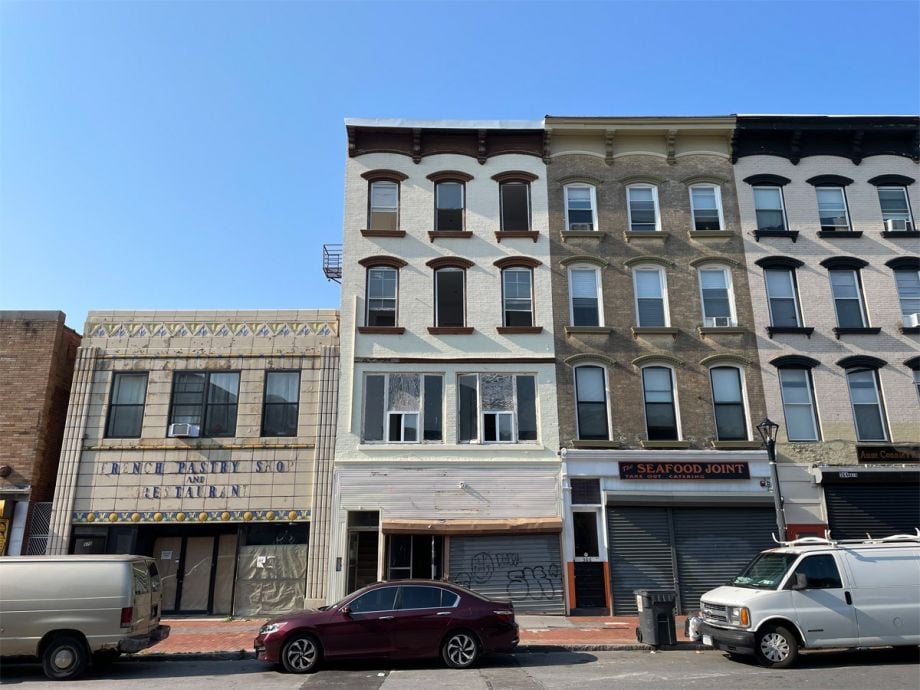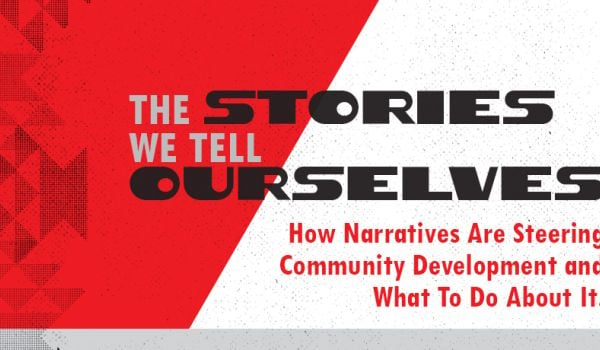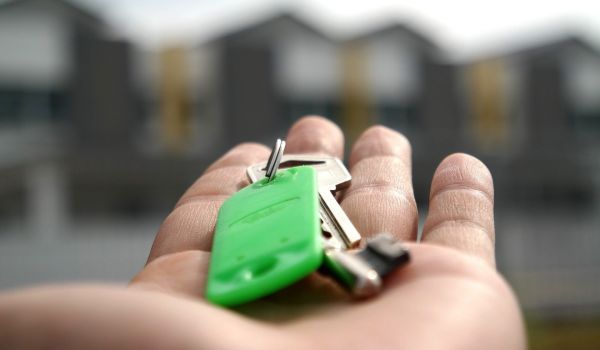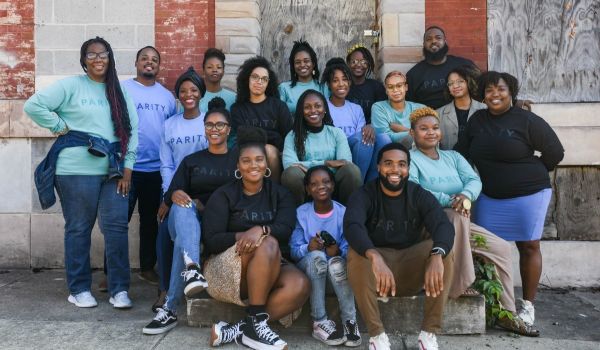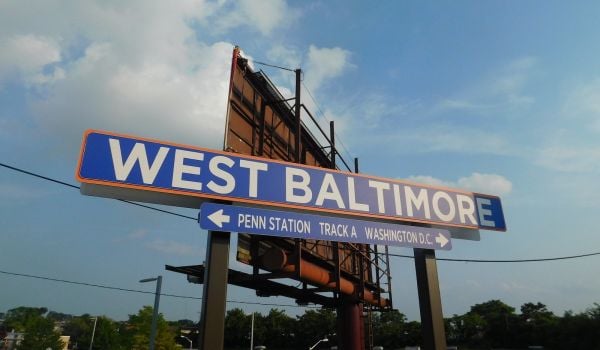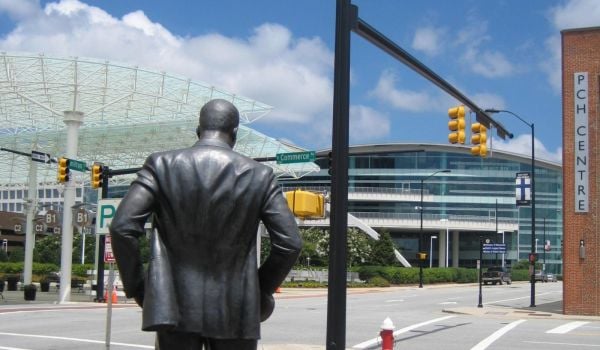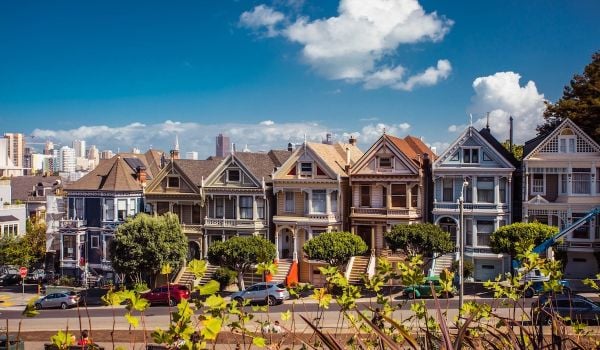Shereen and Garfield Salmon did just about everything expected of them, and yet they were still this close to losing the location for their new cafe.
When they first met, they bonded over the fact each had lived in the same town of Portmore, Jamaica, before emigrating to New York. Their wedding, they say, was like a whole town reunion. That was 17 years and three kids ago.
In 2006, they bought their first home, a three-flat in Mount Vernon. That same year Garfield, who had been working in the food industry, also started training to become a chef, at a culinary school in New York City. With savings from their rental income, they invested in another two-flat in Mount Vernon.
More than a decade later, they finally had enough set aside to start looking for a building to buy and build out their cafe. They first looked in the Bronx, but seven-figure prices there were already too rich for their blood.
In 2018, they finally found it — at 368 Main Street, in historic but disinvested downtown Poughkeepsie. Listed at 7,728 total square feet, the building has a storefront and three stories above — enough room for five apartments. The building needed a lot of work, originally built in 1900 and vacant for the previous eight years. The previous owner of the building was a developer in Queens, Shereen says. From their savings, the Salmons paid $100,000 cash to acquire the building.
Although the area badly needs new investment, it’s not totally deserted. Poughkeepsie’s Main Street is actually home to a concentration of Black-owned businesses. Government offices in the area promise a reliable lunch crowd (assuming most return to the office after the pandemic). Two doors over, a soul food joint opened up in 2019, and it was doing very well until the pandemic hit. Not to mention, in 2019, the city completed a major rezoning of its downtown to encourage redevelopment, which included eliminating the previous zoning requirement that developers build one parking spot for every three seats in a restaurant or cafe location.
After buying the building, the Salmons sank another $200,000 of their own money into badly needed repairs and renovations. They sold their two-flat in Mount Vernon to fund the work. But the costs kept adding up, especially when COVID hit.
So the Salmons needed to take out a loan. They didn’t need much in commercial real estate terms, just under $500,000. But that turned out to be a barrier. Most lenders they spoke to weren’t interested in anything for less than $1.5 million. They almost went with one lender who was going to charge them 15 percent, despite interest rates being at record lows. A representative for another investor strung them along until the last second, when the investor suddenly decided the property was too far from the waterfront. All in all, seven lenders turned them down.
“It was discouraging at times,” says Shereen. “There were times we thought we might need to just sell the building.”
But at one of those moments, in January 2021, a community development official from the county connected them with Community Preservation Corporation. Founded in 1974, CPC is a NYC-based nonprofit with offices in cities across the state, and it specializes in community development lending. It had just launched a new initiative, ACCESS, to work with more developers who look like or come from the communities that the nonprofit has been serving since inception — communities that are disproportionately Black, Latino, or foreign-born.
Despite the fact that this was the Salmons’ first commercial real estate project, and it features a cafe that most lenders consider a very risky investment, CPC extended the couple a $465,000 loan. The ultimate source of the funds was actually the New York State employees public pension fund, a small slice of which CPC has managed since the 1980s.
“This new initiative is about trying to get more Black developers in the door to access those funds to benefit Black communities,” says Lawrence Hammond, senior vice president at CPC.
Ownership patterns matter. They can be a hidden factor that can help determine who benefits from a wave of new investment coming into a community.
One block over from the Salmons’ building on Main Street in Poughkeepsie, Donnell owns Studio Kutz, a barbershop that has been in the same location, with the same landlord, for ten years (Donnell requested to leave out his last name for this story). It’s one of the many Black-owned businesses along the corridor. But the building next door to his is soon to be demolished to make way for a larger building, as well as the three buildings across the street.
For now, as long as his current landlord sticks around, Donnell is excited by the prospect of all the new customers from the new developments going up around his business. Donnell says he’s actually turned down offers from his landlord to sell him the building, because he says at this stage of his life he’s not interested in owning a commercial property.
“I know a lot of businesses around here and none of them own their buildings,” Donnell says.
But the vast majority of buyers with access to capital for commercial real estate don’t look like Donnell, or the Salmons. Commercial real estate has long had “a whiteness problem.” According to Enterprise Community Partners, just two percent of real estate industry firms are Black-led. As sub-sectors of commercial real estate, community development and affordable housing have only helped perpetuate that.
Community development lenders like CPC have emerged over the decades to specialize in lending to projects often in areas that were historically excluded from investment because of redlining, but even they have financed mostly white developers to build, own and profit from affordable housing or other projects in communities of color. CPC itself has financed tens of thousands of affordable housing units in communities of color across New York City and the rest of the state, but according to its own internal analysis, less than 10% of its lending had gone to developers of color, which was lower than expected.
A racial reckoning has been quietly brewing among community development lenders over the past few years. It really came to a head last year, fueled by racial justice uprisings after the deaths of George Floyd, Breonna Taylor and other Black people at the hands of police.
Since 2018, Capital Impact Partners has been training developers of color in Detroit and Washington D.C. through its “Equitable Development Initiative.” But training has never been enough. Even though affordable housing or community development projects might have different goals than most real estate projects, they face many of the same constraints around real estate lending.
Those constraints start with developers needing to bring money to the table (ironically called “equity”), whether it’s their own money or from friends and family. Lenders like to see developers or investors bring equity to the table because it shows the developer has “skin in the game,” meaning they are risking their own money and therefore they’re sufficiently incentivized to make sure the project works out and the lender will be repaid.
But Black households have a median net worth just one-eighth that of white households, according to the Federal Reserve — meaning, Black developers have a much shallower pool of friends and family wealth from which to draw in order to raise funds for developer equity.
Given that disparity, Capital Impact Partners has been seeking out ways to tweak its loan offerings, in order to work with the reality that developers of color as a group, especially Black developers, don’t have much developer equity they can bring to the table for a real estate project.
Meanwhile, Enterprise Community Partners is at the beginning of a five-year, $3.5 billion initiative “to help dismantle the deeply-rooted legacy of racism in housing,” including who builds it. Enterprise plans to provide developers with equity investment as part of its initiative. The Local Initiatives Support Corporation is raising an “Emerging Minority Developers Fund” promising to fill in some of the equity gaps for developers of color. Citi has committed to make equity investments in projects led by developers of color as part of its $1 billion “Action for Racial Equity.” (Citi also provides funding to Next City for The Bottom Line newsletter).
A number of more grassroots efforts have also emerged to bring more diverse leadership into commercial real estate and community development. Since 2016, Building Community Value has been educating and connecting Detroiters so that the city’s real estate industry looks more like its residents, who are 78% Black. In Chicago, Leon Walker has been a rare example of a local Black son of the South Side rising up to become a commercial real estate developer, and is one of the driving forces behind the new Chicago Emerging Minority Developer Initiative. Earlier this year developers of color in Philadelphia formed “The Collective,” an effort to raise capital collectively and diversify the city’s real estate industry.
The Salmons are exceptional by some measures. Most new or emerging developers of color don’t have $100,000 cash to acquire a property. They did. Most new developers of color don’t have a property to sell to raise funds for renovations. They did.
And yet even they were nearly derailed by the racialized landscape of community development and commercial real estate lending. Despite commercial real estate’s apparent obsession with numbers — comps, net operating income, loan to value ratios, debt service coverage ratios, floor area ratios, interest rates, just to name a few — a lot of commercial real estate and even community development lending still comes down to relationships. It’s still largely about who you know, who you trust, and who knows and trusts you.
CPC’s ACCESS initiative hinges largely on the social network aspect of commercial real estate lending. It’s an acknowledgement that it needed to invest more resources into building those relationships. It moved over existing staff to the initiative full time — Hammond, born in Brooklyn, also an ordained minister and holder of a doctoral degree in divinity; and Wilhelmena Norman, who has been with CPC for nine years.
“It’s sort of like friends and family,” says Hammond. “Majority developers oftentimes just have those people they can go to and get the necessary resources. So we see a very strategic position for [the ACCESS team] to fill in that gap. Friends and family will take some risk that others won’t. They believe in your story, they believe in your ability to execute. There’s something internal on the lender side to get a sense that this is something the developer really feels passionate about.”
As Hammonds explains, a single loan officer might want to make a case for the lender to work with and provide post-loan support to someone like the Salmons. Add two more staff as internal champions and for post-loan support to novice commercial real estate developers, and that loan is even more likely to be approved.
“As people of color ourselves, there’s that shared experience,” says Norman.” When we’re talking about recent initiatives like this one created over this period of time, there still aren’t too many that are themselves led by BIPOC individuals.
CPC’s ACCESS team is responsible for just over $4 million in loans so far across the state, with more in the pipeline from New York City to Buffalo and everywhere in between. They’re expecting some of those deals to come out of New York State’s Legacy Cities initiative, a partnership with CPC to transfer portfolios of vacant or abandoned properties into the hands of developers, with a preference for women and developers of color.
The nonprofit has committed $20 million from its own balance sheet to ACCESS deals, but that’s not the only capital it can bring to the table. Depending on the deal, CPC can also tap into the dollars it manages on behalf of the New York City or New York State public pension funds, like it did for the Salmons.
Hammond says CPC is willing to tweak some of its standard lending parameters to make ACCESS deals work for developers of color, but he also explains it’s not as much about tweaks to lending parameters as it is about building a whole new web of relationships. Sometimes, as in the case of the loan it made to the Salmons, CPC didn’t need to make an exception to its lending parameters at all. It just needed to answer the phone.
The Salmons are naming their new venture “The Upstream Cafe,” on track now to open later this year.
“We figured we’re the Salmon family and you know how salmon are always swimming upstream,” says Shereen. “It’s been this upstream journey for us, starting in Jamaica, then Mount Vernon, and now Poughkeepsie. It’s been swimming against the current the whole way.”
This article is part of The Bottom Line, a series exploring scalable solutions for problems related to affordability, inclusive economic growth and access to capital. Click here to subscribe to our Bottom Line newsletter.

Oscar is Next City's senior economic justice correspondent. He previously served as Next City’s editor from 2018-2019, and was a Next City Equitable Cities Fellow from 2015-2016. Since 2011, Oscar has covered community development finance, community banking, impact investing, economic development, housing and more for media outlets such as Shelterforce, B Magazine, Impact Alpha and Fast Company.
Follow Oscar .(JavaScript must be enabled to view this email address)



